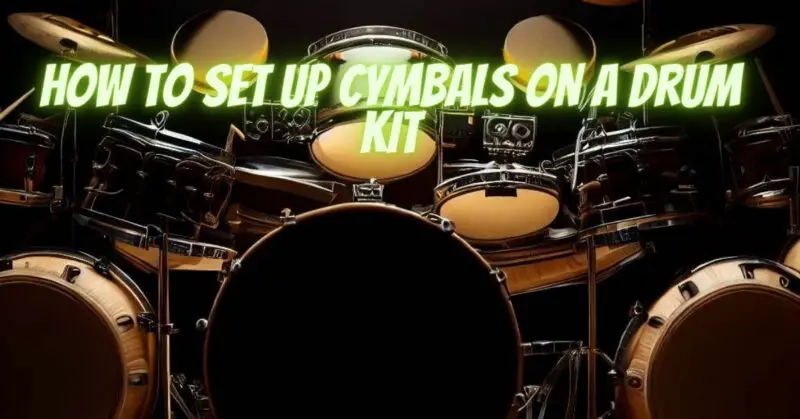Cymbals play a crucial role in defining the character and dynamics of a drum kit. Properly setting up cymbals ensures optimal reach, balance, and sound projection. In this guide, we will walk you through the step-by-step process of setting up cymbals on a drum kit, enabling you to achieve the ideal positioning and create an immersive drumming experience.
- Selection and Placement: Choose the cymbals that best suit your musical style and preferences. Common cymbals include the hi-hat, ride, and crash cymbals. Position the hi-hat to your left side, within comfortable reach of your left foot. Place the ride cymbal to your right side, typically above the floor tom, ensuring it is at a height that allows easy access for drumstick play. Position crash cymbals within reach, usually above the high tom and/or ride cymbal.
- Mounting the Hi-Hat: Attach the hi-hat stand to the designated area on your drum kit, typically to the left of the snare drum. Adjust the height and angle of the stand according to your preference. Mount the top and bottom hi-hat cymbals onto the hi-hat stand, ensuring they are properly aligned and secure. Adjust the tension of the hi-hat clutch to achieve the desired open and closed sound.
- Mounting Ride and Crash Cymbals: Attach the ride cymbal to a cymbal stand positioned on your right side, usually above the floor tom. Adjust the height and angle of the stand to achieve a comfortable playing position. Place the crash cymbals on separate cymbal stands within reach, typically above the high tom and/or ride cymbal. Adjust their height and angle to suit your playing style and desired sound projection.
- Positioning and Angling: Once the cymbals are mounted, fine-tune their positions and angles. The hi-hat cymbals should be parallel to the floor, with the top cymbal slightly tilted towards you. Adjust the ride cymbal angle to your preference, aiming for a comfortable striking surface. Experiment with different positions and angles for the crash cymbals, ensuring they are within reach and offer optimal sound projection.
- Balancing Cymbal Heights: Achieving a balanced cymbal height is essential for comfortable and fluid drumming. Ensure that the hi-hat, ride, and crash cymbals are at similar heights, allowing for seamless transitions between them. Adjust the cymbal stand heights accordingly to achieve a visually appealing and ergonomic setup.
- Testing and Adjusting: Sit behind the drum kit and test the positioning and feel of each cymbal. Play them individually and experiment with various strikes to assess their response and sound quality. Make any necessary adjustments to cymbal positions, angles, or heights to achieve the desired playability and sonic characteristics.
- Cymbal Dampening: If desired, consider using cymbal dampening accessories to control unwanted overtones or sustain. These can include products such as felt washers, cymbal sleeves, or specialty dampening devices. Experiment with different dampening options to find the balance between the cymbal’s natural resonance and the desired sound control.
- Regular Maintenance: Regularly inspect and clean your cymbals to maintain their sound quality and longevity. Use appropriate cymbal cleaning products and follow manufacturer guidelines to remove dirt, fingerprints, or oxidation. Avoid using harsh chemicals or abrasive materials that could damage the cymbal surfaces.
Conclusion:
By following these step-by-step instructions, you can set up your cymbals on a drum kit with precision and care. Remember toselect cymbals that suit your musical style, position them within comfortable reach, and fine-tune their height, angle, and positioning. Regularly maintain and clean your cymbals to preserve their sound quality and extend their lifespan. With a well-arranged cymbal setup, you’ll be able to unleash your creativity, enhance your drumming dynamics, and create captivating rhythms that leave a lasting impact.

